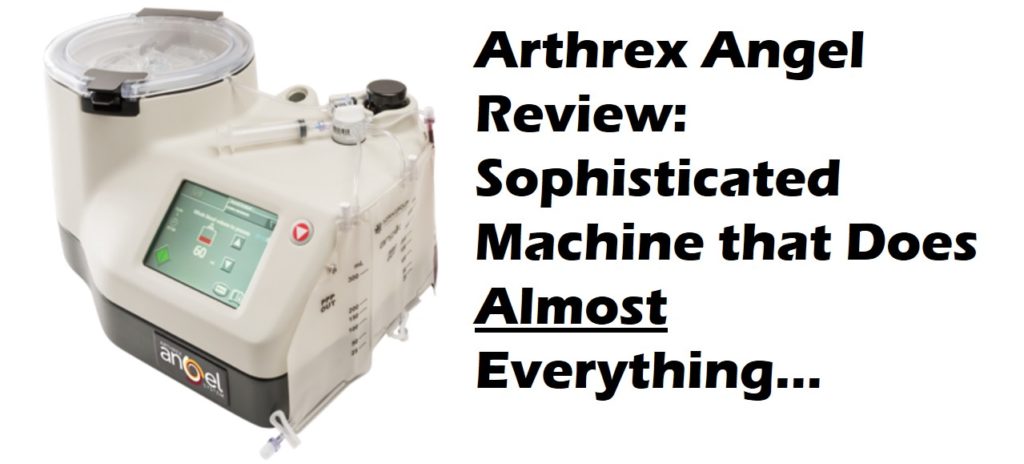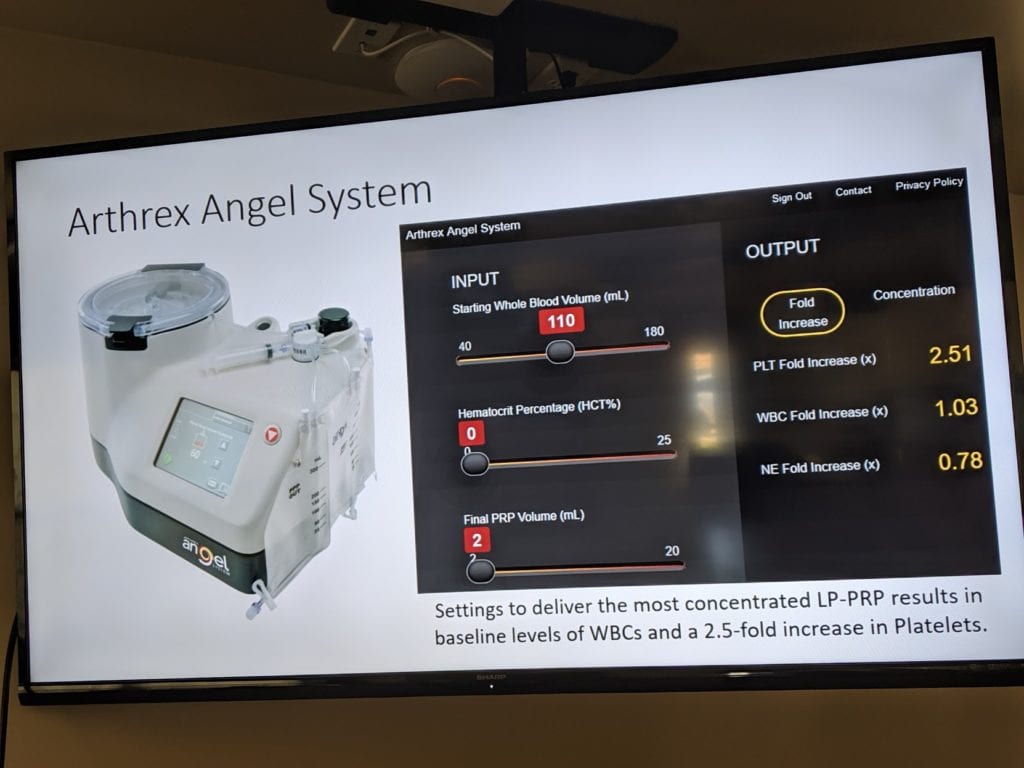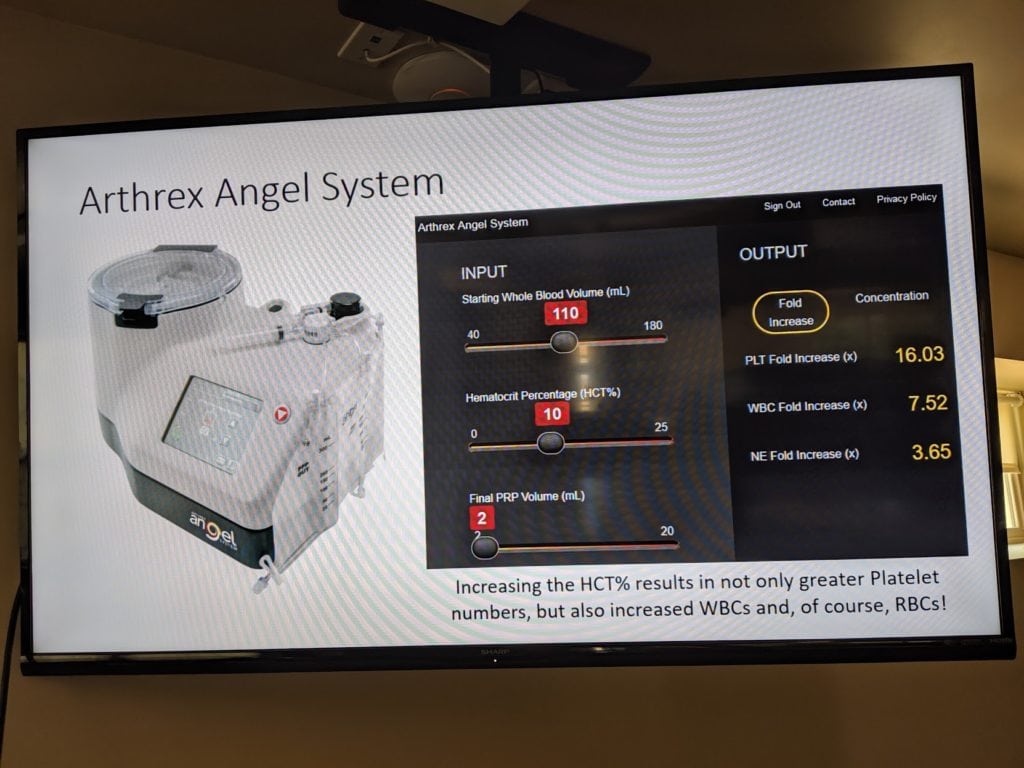Arthrex Angel Review: Is This the Holy Grail of Bedside Machines?

What Can We Do in an On-site Lab that’s Unique?
The hand processing that occurs using our protocols allows for a much higher concentration of platelets in PRP and stem cells in bone marrow concentrate. We also have flexibility in increasing or decreasing certain cell types. For example, we can make a white blood cell (leukocyte) poor PRP that still has a very high platelet concentration. To learn more about these Flexible Lab Platforms, see my video below:
What is a Bedside Machine?
Most doctors use small, automated machines that come with kits. The advantage is ease of use, as all the doctor and their staff need to know is where to put the blood or bone marrow sample and where the “On” button is located. The disadvantage is that you tend to get a one size fits all approach. Meaning, what’s outputted is not as customizable for each patient.
The Arthrex Angel System
If any PRP or bone marrow concentrate system on the market could compete with a Flexible Lab Platform, based on the marketing collateral, it would be the Arthrex Angel system. First, the thing is a looker with a big touch screen and three LASERs. Those are used to differentiate when certain cell types end and others begin in a centrifuged sample. Second, the system claims to be completely customizable. For example, for PRP, you can dial in the concentration of platelets, white cells, and even the volume inputted or what the machine produces. Third, Arthrex is a trusted name in orthopedic devices.
As shown in the video above, the machine has a centrifuge that uses a specialized disposable disc where it spins the cells. Then it feeds the centrifuged product through a series of LASERs of different wavelengths and uses those to open and close valves that can separate the parts of the product. So, for example, you can have a “Leukocyte Reduced” protocol and it will reduce the number of white blood cells in the final PRP.
The Downsides
I had our lab staff do some research, as I was interested to see if, finally, an automated machine was sophisticated enough to replace lab processing. Regrettably, for us, based on what we were able to find out using Arthrex’s online calculator for the device, the reality is that the machine does much well, but falls short in some critical areas. Let’s review.
The images above come from our weekly science meeting at Regenexx. Here you see that our lab staff has set the machine to accept a lot of blood (110 cc) and have asked it to reduce the red blood cell percentage to zero. It has also asked it to deliver only 2 cc of blood back, which should mean that we should get a hyper-concentrated, leukocyte-poor (and red blood cell free or amber) PRP. However, the machine is only concentrating platelets 2.5x. As a comparison, with these sorts of numbers, we could easily deliver a 20X+ concentration of platelet back to the patient! In addition, note that the WBC’s we want to eliminate in this kind of prep are still here in spades and slightly concentrated at 1.03 times above baseline. Huh…
Next, we began playing with various controls to see if we could get a higher platelet concentration. We kept the other parameters the same and found that we could get very high concentrations of platelets, but that came at a price. In the case above, those settings made the PRP red by adding in 10% RBCs and also dramatically increased the white blood cells to 7.5X! So getting our high dose PRP without red blood cells or white blood cells didn’t seem possible with this machine. Why? It’s likely that the centrifuge is driving the platelets into the same area as the white and red blood cells, so separating these out is not possible.
Why are RBCs and WBCs a Big Deal?
There’s been an ongoing debate in the orthobiologics community for years between leukocyte-poor (amber colored aka LP-PRP) and leukocyte-rich (red colored or aka LR-PRP). Based on the many research reviews I’ve done, LP-PRP has an edge right now in research showing that it works better for most applications. However, one area where LR-PRP may be better is at fighting infection, due to the presence of all of those white blood cells. In addition, our research has demonstrated that red blood cells can inhibit mesenchymal stem cell growth in culture, but how that translates into humans is unknown.
The upshot? This is a VERY cool machine. It does more than most machines out there and has more flexibility than just about any device I’ve looked at to date. Regrettably, it doesn’t yet meet our specs, as there are things we can do in the lab that this device can’t match, but maybe one day?

NOTE: This blog post provides general information to help the reader better understand regenerative medicine, musculoskeletal health, and related subjects. All content provided in this blog, website, or any linked materials, including text, graphics, images, patient profiles, outcomes, and information, are not intended and should not be considered or used as a substitute for medical advice, diagnosis, or treatment. Please always consult with a professional and certified healthcare provider to discuss if a treatment is right for you.


